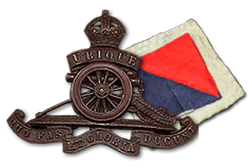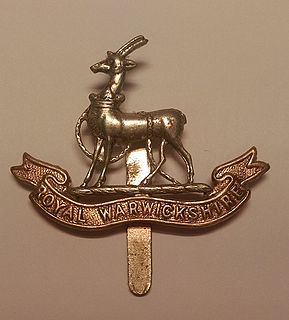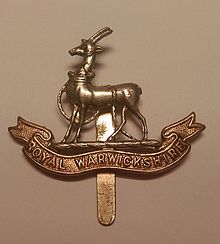
The 79th Heavy Anti-Aircraft Regiment, Royal Artillery was an air defence unit of Britain's Territorial Army (TA). Formed just before World War II, it fought in the Battle of France, the Swansea Blitz, Operation Torch and the Italian Campaign. It continued serving in the post-war TA until 1955.

The IV Home Counties (Howitzer) Brigade, Royal Field Artillery was a new volunteer unit formed in Kent as part of the Territorial Force (TF) in 1908. It saw active service on the Western Front during World War I and was reconstituted as medium artillery in the interwar years. Later it converted to anti-aircraft artillery, in which role it served in The Blitz, North Africa and Italy during World War II and continued under various designations until its disbandment in 1969.

The 89th Heavy Anti-Aircraft Regiment, Royal Artillery was an air defence unit of Britain's Territorial Army (TA) raised in Kent just before the outbreak of World War II. It served during the Battle of Britain and defended the Suez Canal while batteries served in the Battle of Crete and the Siege of Tobruk. The regiment then fought through the North African and Italian campaigns.

88th Heavy Anti-Aircraft Regiment, Royal Artillery (TA) was a volunteer air defence unit of Britain's Territorial Army (TA) from 1939 until amalgamated in 1950. During World War II it defended South Wales and the Severn Valley during the Blitz and then took part in the North African and Italian campaigns, fighting in both the anti-aircraft (AA) and ground fire roles.

248th (Welwyn) Heavy Anti-Aircraft Battery, Royal Artillery, was an air defence unit of Britain's Territorial Army (TA). Formed just before World War II, it fought in the Battle of France and the Swansea Blitz, and later defended London and Cyprus. It continued serving in the post-war TA until 1955.

120th Heavy Anti-Aircraft Regiment, Royal Artillery was an air defence unit of the British Army during World War II. Raised in early 1941, it served to protect South Wales and London before proceeding overseas in 1943. It provided anti-aircraft (AA) cover over Cyprus until its disbandment in 1944.

91st Heavy Anti-Aircraft Regiment, Royal Artillery was a part-time unit of Britain's Territorial Army (TA) formed in the West Riding of Yorkshire just before the outbreak of World War II. Its service during the war included Home Defence during the Battle of Britain and The Blitz, and a length period in Middle East Forces. Postwar it continued to serve in the TA in the air defence role until 1955.

The 6th Battalion, Royal Warwickshire Regiment was a unit of Britain's Territorial Army (TA) from 1908 until 1961. Recruited from Birmingham, it served as infantry in some of the bloodiest fighting on the Western Front and in Italy during World War I. Converted to an Anti-Aircraft (AA) role, it defended the West Midlands during The Blitz in the early part of World War II, and then joined Eighth Army in North Africa, including service in the famous Siege of Tobruk and in the Italian Campaign. It served on in the air defence role in the postwar TA until 1961.

7th Heavy Anti-Aircraft Regiment, Royal Artillery was an air defence unit of the British Army that served in the Siege of Malta during World War II. It fired the first British shots in the Mediterranean Theatre in the war, and provided the basis on which the heavy anti-aircraft defences of Malta were built. Late in the war it returned to defend the UK against V-1 flying bombs, and continued in the postwar army until 1954.

6th Heavy Anti-Aircraft Regiment, Royal Artillery was an air defence unit of the British Army raised in the years leading up to World War II. It served in the Battle of France and was evacuated from Dunkirk. Re-equipped, it defended London and the West Midlands during the Battle of Britain and The Blitz. It was then sent to the Middle East theatre, but was diverted en route to the Far East, where the Japanese Army had invaded British Malaya. Split up, ill-equipped and fighting against overwhelming odds, the regiment was captured in Java, Dutch East Indies, in March 1942. Many of the men taken prisoner later died working on the Burma Railway and in the 'Hell Ships' taking them to work in Japan. Its successor unit served in the post-war British Army until 1958.
2nd Anti-Aircraft Brigade was an air defence formation of the British Army during World War II, seeing active service in the Battle of France and the North African and Italian campaigns.

The 4th North Midland Brigade, sometimes known as the 'Derbyshire Howitzers', was a part-time unit of Britain's Royal Field Artillery created in 1908 as part of the Territorial Force. It served on the Western Front in World War I. Reorganised between the wars, it was later converted to the anti-aircraft (AA) role. During World War II, part of the regiment served in the Siege of Malta but the rest was captured at the Fall of Tobruk. The reconstituted regiment served on in Anti-Aircraft Command until 1955 and as a unit of the Royal Engineers until 1967.

10th Heavy Anti-Aircraft Regiment, Royal Artillery was an air defence unit of the British Army that served in the Mediterranean Theatre during World War II. Having been formed in Gibraltar early in the war, it moved to Malta where it defended the island during the Siege of 1940–43.

The Carmarthenshire Fortress Royal Engineers (CFRE) was a coast defence unit of Britain's Territorial Army formed after World War I. In World War II, it provided an anti-aircraft searchlight unit that served during the early part of The Blitz, and then during the Siege of Malta.

82nd (Essex) Heavy Anti-Aircraft Regiment, Royal Artillery, was a volunteer air defence unit of Britain's Territorial Army (TA) from 1938 until 1955. During World War II it served in the Norwegian Campaign, defended Gibraltar and the D-Day invasion ports, and took part in Operation Diver against the V-1 flying bombs.

191st Heavy Anti-Aircraft Battery, Royal Artillery, was an air defence unit of Britain's Territorial Army formed in Birmingham before World War II. It defended the West Midlands against attack during the Battle of Britain, and was then shipped to Malta, where it served through most of the long siege when the island fortress was bombed incessantly.

98th Heavy Anti-Aircraft Regiment, Royal Artillery, was an air defence unit of Britain's Territorial Army (TA) formed in Gloucestershire during the period of international tension leading up to the outbreak of World War II. It defended aircraft factories during the Battle of Britain, then the city of Manchester during the Blitz. It later served in the campaign in North West Europe. The regiment continued in the postwar TA until amalgamated in 1955.

The 32nd Light Anti-Aircraft Regiment, Royal Artillery, was a Scottish air defence unit of Britain's Territorial Army (TA) during World War II. After serving with Anti-Aircraft Command in the defence of the UK, it went to Malta and served for two years in the defence of the besieged island. It then landed in Normandy in August 1944 and fought through the campaign in North West Europe, notably at the Siege of Dunkirk, where it was used in a siege gun role, and in the crossing of the Rhine, until VE Day. The regiment was reformed in the postwar TA but was amalgamated with other Scottish anti-aircraft units in 1950.

The 4th Searchlight Regiment, Royal Artillery/Royal Malta Artillery was a composite unit of the Royal Artillery (RA) and Royal Malta Artillery (RMA) formed on Malta during the Siege of the island in World War II. As well as RA and RMA subunits, it also included a contingent of searchlight (S/L) operators from the Royal Engineers (RE), and was initially commanded by an RE officer.

15th Anti-Aircraft Brigade was an air defence formation of the Royal Artillery which saw service during the middle years of World War II. The brigade was formed in Gibraltar to control those AA units based there and disbanded shortly after the air threat had been diminished in 1944. The brigade was later reformed in 1947 as part of the post-war regular army, but disbanded in 1957 following the end of the AA era.










